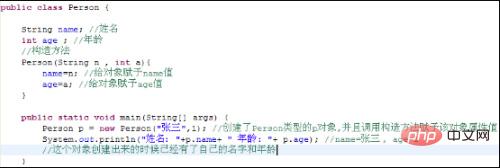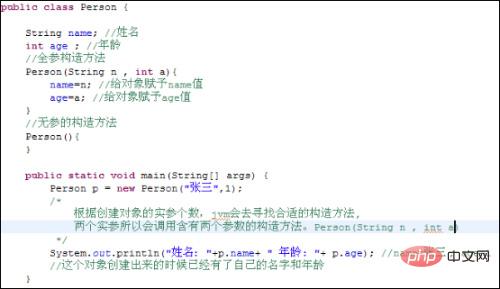
The constructor is a member of the object-oriented system. The constructor can be called a constructor. Its function name is the same as the class name. There is no need to define a return value type and no specific return value. . The constructor is a function called when constructing a created object. Its function is to initialize the object. All objects created must be initialized through the constructor. If there is no constructor defined in a class, the class will have a default constructor with empty parameters. If a specified constructor is defined in a class, there is no default constructor in the class.
When we are born, some people are given names after they are born, but some people are already given names as soon as they are born. So how do we assign a value to an object once it is created in Java?


1. The role of the constructor:
The role of the constructor: perform operations on the object initialization.
As shown in the figure:

2. The difference between constructors and ordinary functions:
(1) General Functions are used to define the functionality that an object should have. The constructor defines some content that the object should have when it is created before calling the function. That is, the initialization content of the object.
(2) The constructor is called by jvm when the object is created to initialize the object. Generally, a function will be executed when the object calls the function after the object is created.
(3) Ordinary functions can be called multiple times using objects, and the constructor is called when the object is created.
(4) The function name of the constructor must be the same as the class name, and ordinary functions only need to comply with the naming rules of identifiers.
(5) The constructor has no return value type.
3. Details to pay attention to in the constructor:
(1) When there is no constructor defined in the class, the system will assign an empty parameter to the class. 's constructor. This is the default constructor in the class. When a constructor is customized in a class, the default constructor is gone.
Note: It can be verified through javap command.
(2) Multiple constructors can be defined in a class to perform different initialization. Multiple constructors exist in a class and are embodied in the form of overloading. Because the names of the constructors are all the same.
class Perosn{
private int id;
private String name;
private int age;
public Perosn(){
cry();
}
public Perosn(int id, String name, int age) {
this.id = id;
this.name = name;
this.age = age;
}
public int getId() {
return id;
}
public void setId(int id) {
this.id = id;
}
public String getName() {
return name;
}
public void setName(String name) {
this.name = name;
}
public int getAge() {
return age;
}
public void setAge(int age) {
this.age = age;
}
public void cry(){
System.out.println("哇哇哇....");
}
}Question: Every child is required to cry when he is born. This code has two constructors. If every child is required to cry when he is born, cry() needs to be called in different constructors. ) function, but this will cause code duplication problem, so how to solve it? Construct code blocks.
4. Construction code block:
The function of the construction code block: to uniformly initialize all objects.
class Perosn{
private int id;
private String name;
private int age;
{
cry();// 每個Person對象創(chuàng)建出來都會執(zhí)行這里的代碼
}
public Perosn(){
cry();
}
public Perosn(int id, String name, int age) {
this.id = id;
this.name = name;
this.age = age;
}
public int getId() {
return id;
}
public void setId(int id) {
this.id = id;
}
public String getName() {
return name;
}
public void setName(String name) {
this.name = name;
}
public int getAge() {
return age;
}
public void setAge(int age) {
this.age = age;
}
public void cry(){
System.out.println("哇哇哇....");
}
}Specific functions:
1: Initialize the object. Runs as soon as the object is created and takes precedence over the constructor.
2: Difference from constructor
(1) The difference between constructed code block and constructor function. Constructed code block is to uniformly initialize all objects, and constructor function is to The corresponding object is initialized.
(2) The function of the construction code block: Its function is to extract the common information in all construction methods.
For example, a child cries uniformly upon birth
The code is as follows:
class Boy {
String name;
int age;
String gender;
// 構造代碼塊,給所有對象進行初始化。
{
System.out.println("哭。。。");
}
Boy() {
System.out.println("無參構造");
}
Boy(String n, int a, String g) {
name = n;
age = a;
gender = g;
System.out.println("有參構造");
}
void run() {
System.out.println("跑...");
}
}
class Demo9 {
public static void main(String[] args) {
System.out.println();
Boy b = new Boy();
Boy b2 = new Boy("jack", 1, "男");
}
}php Chinese website, a large number of free Java introductory tutorials, welcome online study!
The above is the detailed content of what is java constructor. For more information, please follow other related articles on the PHP Chinese website!

Hot AI Tools

Undress AI Tool
Undress images for free

Undresser.AI Undress
AI-powered app for creating realistic nude photos

AI Clothes Remover
Online AI tool for removing clothes from photos.

Clothoff.io
AI clothes remover

Video Face Swap
Swap faces in any video effortlessly with our completely free AI face swap tool!

Hot Article

Hot Tools

Notepad++7.3.1
Easy-to-use and free code editor

SublimeText3 Chinese version
Chinese version, very easy to use

Zend Studio 13.0.1
Powerful PHP integrated development environment

Dreamweaver CS6
Visual web development tools

SublimeText3 Mac version
God-level code editing software (SublimeText3)

Hot Topics
 How to iterate over a Map in Java?
Jul 13, 2025 am 02:54 AM
How to iterate over a Map in Java?
Jul 13, 2025 am 02:54 AM
There are three common methods to traverse Map in Java: 1. Use entrySet to obtain keys and values at the same time, which is suitable for most scenarios; 2. Use keySet or values to traverse keys or values respectively; 3. Use Java8's forEach to simplify the code structure. entrySet returns a Set set containing all key-value pairs, and each loop gets the Map.Entry object, suitable for frequent access to keys and values; if only keys or values are required, you can call keySet() or values() respectively, or you can get the value through map.get(key) when traversing the keys; Java 8 can use forEach((key,value)->
 Java Optional example
Jul 12, 2025 am 02:55 AM
Java Optional example
Jul 12, 2025 am 02:55 AM
Optional can clearly express intentions and reduce code noise for null judgments. 1. Optional.ofNullable is a common way to deal with null objects. For example, when taking values ??from maps, orElse can be used to provide default values, so that the logic is clearer and concise; 2. Use chain calls maps to achieve nested values ??to safely avoid NPE, and automatically terminate if any link is null and return the default value; 3. Filter can be used for conditional filtering, and subsequent operations will continue to be performed only if the conditions are met, otherwise it will jump directly to orElse, which is suitable for lightweight business judgment; 4. It is not recommended to overuse Optional, such as basic types or simple logic, which will increase complexity, and some scenarios will directly return to nu.
 How to fix java.io.NotSerializableException?
Jul 12, 2025 am 03:07 AM
How to fix java.io.NotSerializableException?
Jul 12, 2025 am 03:07 AM
The core workaround for encountering java.io.NotSerializableException is to ensure that all classes that need to be serialized implement the Serializable interface and check the serialization support of nested objects. 1. Add implementsSerializable to the main class; 2. Ensure that the corresponding classes of custom fields in the class also implement Serializable; 3. Use transient to mark fields that do not need to be serialized; 4. Check the non-serialized types in collections or nested objects; 5. Check which class does not implement the interface; 6. Consider replacement design for classes that cannot be modified, such as saving key data or using serializable intermediate structures; 7. Consider modifying
 Comparable vs Comparator in Java
Jul 13, 2025 am 02:31 AM
Comparable vs Comparator in Java
Jul 13, 2025 am 02:31 AM
In Java, Comparable is used to define default sorting rules internally, and Comparator is used to define multiple sorting logic externally. 1.Comparable is an interface implemented by the class itself. It defines the natural order by rewriting the compareTo() method. It is suitable for classes with fixed and most commonly used sorting methods, such as String or Integer. 2. Comparator is an externally defined functional interface, implemented through the compare() method, suitable for situations where multiple sorting methods are required for the same class, the class source code cannot be modified, or the sorting logic is often changed. The difference between the two is that Comparable can only define a sorting logic and needs to modify the class itself, while Compar
 Java method references explained
Jul 12, 2025 am 02:59 AM
Java method references explained
Jul 12, 2025 am 02:59 AM
Method reference is a way to simplify the writing of Lambda expressions in Java, making the code more concise. It is not a new syntax, but a shortcut to Lambda expressions introduced by Java 8, suitable for the context of functional interfaces. The core is to use existing methods directly as implementations of functional interfaces. For example, System.out::println is equivalent to s->System.out.println(s). There are four main forms of method reference: 1. Static method reference (ClassName::staticMethodName); 2. Instance method reference (binding to a specific object, instance::methodName); 3.
 How to handle character encoding issues in Java?
Jul 13, 2025 am 02:46 AM
How to handle character encoding issues in Java?
Jul 13, 2025 am 02:46 AM
To deal with character encoding problems in Java, the key is to clearly specify the encoding used at each step. 1. Always specify encoding when reading and writing text, use InputStreamReader and OutputStreamWriter and pass in an explicit character set to avoid relying on system default encoding. 2. Make sure both ends are consistent when processing strings on the network boundary, set the correct Content-Type header and explicitly specify the encoding with the library. 3. Use String.getBytes() and newString(byte[]) with caution, and always manually specify StandardCharsets.UTF_8 to avoid data corruption caused by platform differences. In short, by
 How to parse JSON in Java?
Jul 11, 2025 am 02:18 AM
How to parse JSON in Java?
Jul 11, 2025 am 02:18 AM
There are three common ways to parse JSON in Java: use Jackson, Gson, or org.json. 1. Jackson is suitable for most projects, with good performance and comprehensive functions, and supports conversion and annotation mapping between objects and JSON strings; 2. Gson is more suitable for Android projects or lightweight needs, and is simple to use but slightly inferior in handling complex structures and high-performance scenarios; 3.org.json is suitable for simple tasks or small scripts, and is not recommended for large projects because of its lack of flexibility and type safety. The choice should be decided based on actual needs.
 Outlook shortcut for new email
Jul 11, 2025 am 03:25 AM
Outlook shortcut for new email
Jul 11, 2025 am 03:25 AM
How to quickly create new emails in Outlook is as follows: 1. The desktop version uses the shortcut key Ctrl Shift M to directly pop up a new email window; 2. The web version can create new emails in one-click by creating a bookmark containing JavaScript (such as javascript:document.querySelector("divrole='button'").click()); 3. Use browser plug-ins (such as Vimium, CrxMouseGestures) to trigger the "New Mail" button; 4. Windows users can also select "New Mail" by right-clicking the Outlook icon of the taskbar






